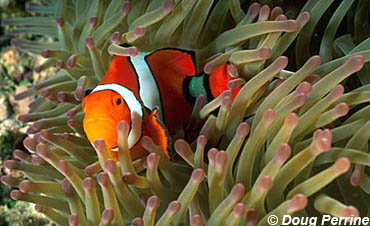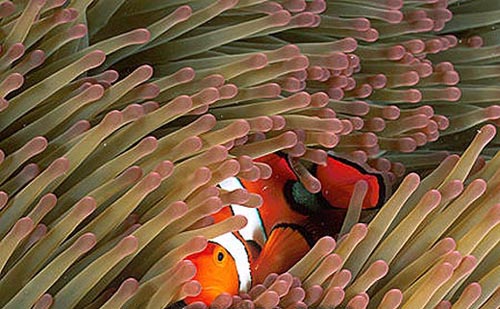
Amphiprion percula
These small reef fish spend a great deal of their lives in a symbiotic relationship with a specific anemone, often with a mate and several non-breeding fish. They are protandrous hermaphrodites, which means all fish are males except for the largest of the group, which is female. Once the female dies, the largest male becomes female, and the others move up the hierarchy. These clownfish are often confused with the clown anemonefish in that they are both vibrant orange with three white bands, but this clownfish has very distinct black borders between the white and the orange. When very young, each clownfish builds an immunity to the stinging tentacles of its chosen anemone through being stung several times and developing a mucous covering its skin.
Order – Perciformes
Family – Pomacentridae
Genus – Amphiprion
Species – percula
Common Names
A. percula is known as an anemonefish because of its symbiotic relationship with sea anemones. Other English language common names include blackfinned clownfish, clown anemonefish, clownfish, eastern clownfish, and orange- clown anemonefish. Common names in other languages are bantay bot-bot (Cebuano); orangegul klovnfisk (Danish); pata (Davawenyo); maumanu ni masao (Gela); clownfisch (German); samok-samok (Kagayanen); paja-paja (Makassarese); clown fish biak, gelang roay (Malay); amfiprion (Polish); baro-baro (Visayan); and bantay-kibot (Waray-waray).
Importance to Humans
This species is not harvested for consumption but is popular in the aquarium trade. This species is often kept by home aquarists due to its hardiness in captivity. Recently, there has been a surge in interest as a result of Disney’s film Finding Nemo, in which the main character is an orange-clown anemonefish named “Nemo”.
Conservation
The orange-clown anemonefish is not listed on the World Conservation Union (IUCN) Red List as an endangered or threatened species. IUCN is a global union of states, governmental agencies, and non-governmental organizations in a partnership that assesses the conservation status of species. This fish is successfully raised in aquaculture facilities which decreases the pressure on wild populations to supply the saltwater aquarium trade.
> Check the status of the orange clownfish at the IUCN website.
Geographical Distribution

The orange clownfish is native to the tropical waters of the Indo-Pacific region. Their distribution ranges from Northern Queensland, Australia to Melanesia, including New Britain, New Guinea, New Ireland, the Solomon Islands, and Vanuatu.
Habitat
The orange clownfish is a non-migratory species that lives in tropical marine lagoons and seaweed reefs at depths ranging from 3 to 49 feet (1 to 15 m). This fish forms symbiotic associations with the anemones Heteractis crispa, Heteractis magnifica in outer reefs, and Stichodactyla gigantea on shore reefs.
Biology

Distinctive Features
The orange clownfish has 30-38 pored scales with no interruptions along the lateral line. Their dorsal fins contain a total of 9 or 10 spines.
The orange clownfish resembles the clown anemonefish (Amphiprion ocellaris), however there are some characters which distinguish it. One distinction between these two species is the black band that separates the orange color from the white bands. The orange clownfish has thick black bands that separate the orange and white coloration on the body while the clown anemonefish has thin black bands which are sometimes so thin that they appear to be absent. Also, the orange clownfish has a more brilliant coloration than that of the clown anemonefish. When viewed from a head-on perspective, the orange clownfish has a head with a pronounced bulge similar to a frog while the clown anemonefish lacks this bulge. These two species also differ in the color of the iris. The orange clownfish has a bright orange iris which has the effect of making the eyes look smaller, while the clown anemonefish possesses a grayish orange iris which gives the appearance of the eyes being larger than they actually are.
Coloration
The orange clown-anemonefish is orange with three white bands on the head, middle, and tail regions. The middle band bulges forward toward the head centrally. Black stripes separate the orange and white coloration on the body. The bands can range from a thick black line to patches of black on the sides of the anemonefish. The fins of the orange-clown anemonefish have black tips.
Size, Age, and Growth
The maximum reported total length of this anemonefish is 4.33 inches (11.0 cm). The standard length of the male orange-clown anemonefish is 1.42 inches (3.6 cm), while the female is larger at a standard length of 1.81 inches (4.6 cm). These fish are highly resilient fish with a minimum population doubling time of less than 15 months. In the wild, they live 6 to 10 years, while in captivity they are recorded as living as long as 18 years.
Food Habits
The diet of the orange-clown anemonefish consists of numerous prey items. They forage on algae and plankton as well as obtain food from the host anemone. The anemonefish will eat the dead tentacles of the anemone and any leftover food prey from the stinging tentacles of the anemone.
Reproduction
The mating behavior of the orange-clown anemonefish takes place in a social group consisting of a breeding pair and 0-4 non-breeding fish, with a strict dominance hierarchy. The larger fish is always the female while the second largest is the male. They are the only two individuals that reproduce within the group. The non-breeding individuals progressively decrease in size further down the hierarchy.Anemonefishes are characterized by being protandrous hermaphrodites which means that all fish develop into males first and then potentially into females later. More than one anemonefish may reside in the same anemone, however if the female were to be removed from the group or die, the largest male would then become female. Females control males through aggressive dominance, thereby controlling the formation of other females.The warm tropical waters where this species resides allows for year-round spawing. The monogamous bond between the male and female is very strong. Days before spawning occurs, the male’s behavior changes to include extending his anal, dorsal and pelvic fins as well as preparing the nest. The nest site is critical to the survival of the eggs. Nests are usually located on a patch of bare rock under the protection of the host anemone’s tentacles. This bare rock is initially cleaned by the male with his mouth, who is later assisted by the female. However, after spawning occurs, male parental care is crucial during the time when the eggs are vulnerable to predators.Spawning activity may last from 30 minutes to over 2 hours during which the female makes multiple passes over the nest, releasing eggs each time as she gently brushes the surface of the nest. She is closely followed by the male who externally fertilizes the eggs as she releases them. The number of eggs released may vary from 100 to over 1,000, dependent upon the size and age of the female. Each egg measures 3-4 mm in length.
The male mouths and fans the eggs throughout the incubation period while also being on guard against predators. Additional protection from predators is provided by the host anemone’s stinging tentacles. The male also removes dead eggs and debris to keep the nest well oxygenated.
Incubation takes 6-7 days, followed by the release of a larva from each egg measuring 3-4 mm in total length. The newly hatched larva sinks to the benthic environment but then quickly swims to the surface of the water via “phototaxis”, using light to orient itself. The larva then spends approximately a week among the plankton. At about 8-12 days after hatching, the juvenile anemonefish settles to the bottom in search of a host anemone. Repeated interactions with a host anemone stimulates the anemonefish to produce its protective mucous coating in the process of acclimation. It is believed that during the first encounter with the anemone, the orange-clown anemonefish lightly touches the tentacles with its ventral fins, followed by its entire body. It may be stung by the tentacles numerous times before acclimation occurs.
Predators
The orange-clown anemonefish are prey for a number of fish such as sharks, stingrays, and other larger bony fishes. While the eggs are susceptible to predators, they are attached to a substrate that is protected by the anemone’s stinging tentacles.
Taxonomy
The orange clownfish was first described by Lacepede in 1802 as Lutjanus percula and later redescribed as Amphiprion percula. The genus name Amphiprion is derived from the the Greek word “amphi” which means on both sides and the Greek word “prion” which means saw. A synonym used in past scientific literature is Amphiprion tunicatus by Cuvier in 1830.
Prepared by: Stephanie Boyer